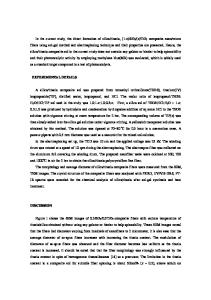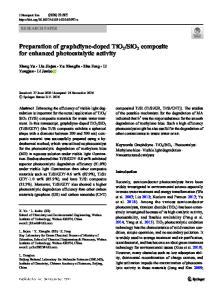Preparation of SiO 2 /YPO 4 :Nd/SiO 2 composite microspheres with near-infrared luminescence and surface functionalizati
- PDF / 4,389,003 Bytes
- 10 Pages / 547.087 x 737.008 pts Page_size
- 88 Downloads / 344 Views
RESEARCH PAPER
Preparation of SiO2/YPO4:Nd/SiO2 composite microspheres with near-infrared luminescence and surface functionalization Yunjiang Yang & Xiaowei Zhu & Jinrong Bao & He Bai & Anping Wu & Yan Qiao & Yulong Bian & Xin Zhao & Wenxian Li & Ying Liu Received: 16 May 2020 / Accepted: 14 October 2020 # Springer Nature B.V. 2020
Abstract In this study, the core/shell/shell-structured SiO2/YPO4:Nd/SiO2 composite microspheres with near-infrared luminescence property were prepared by sol-gel method. The morphology and structure of the asprepared microspheres were observed by transmission electron microscopy (TEM), energy-dispersive X-ray spectroscopy (EDX), X-ray diffraction (XRD), and infrared spectroscopy (IR). These tests show that the composite microspheres have a sandwich structure. The diameter of the core SiO2 microspheres is ~ 220 nm, the intermediate layer thickness of rare-earth phosphate is ~ 5 nm, and the outer SiO2 layer is ~ 20 nm thick. The core/shell/shell microspheres are emitted at 1063 nm in the near-infrared region, which attributes to optical transparent windows of biological tissues. Meanwhile, the interaction between the composite microspheres and bovine serum albumin (BSA) was investigated. The results showed that the composite microspheres could quench the emission intensity of BSA
Electronic supplementary material The online version of this article (https://doi.org/10.1007/s11051-020-05053-9) contains supplementary material, which is available to authorized users. Y. Yang : J. Bao (*) : H. Bai : A. Wu : Y. Qiao : Y. Bian : X. Zhao : W. Li : Y. Liu Inner Mongolia Key Laboratory of Chemistry and Physics of Rare Earth Materials, College of Chemistry and Chemical Engineering, Inner Mongolia University, Hohhot 010021, China e-mail: [email protected] X. Zhu College of Pharmacology, Inner Mongolia Medical University, Hohhot 010110, China
by binding the tryptophan residues in BSA. The synthesized core/shell/shell composite microspheres may be used as near-infrared luminescence probes in the field of biological tissue imaging. Keywords Rare earth phosphate . Core/shell/shell . Near-infrared luminescence . BSA . Nanoscale shell thickness
Introduction The near-infrared light (NIR) is the optical transparent window of biological tissues (Chen et al. 2010; 2012; Zhang et al. 2014). Microwatt near-infrared light can penetrate nearly 10 cm of breast tissues and about 4 cm of brain or muscle tissues (Li et al. 2015). On account of these advantages, deep tissue imaging using nearinfrared light was increasingly valued in physiological research and biomedical applications, such as the cell labeling, in vivo biosensing, and drug-sustained release monitoring (Zhao et al. 2019; Liu et al. 2018; Yao et al. 2016). In the past decades, UV-vis luminescent probes had been widely used to the field of biomedicine because of its high sensitivity, rapid response, and high spatiotemporal resolution of multi-channel (multi-color) observation (James and Gambhir 2012; Ntziachristos 2010; Yun and Kwok 2017). To date
Data Loading...











